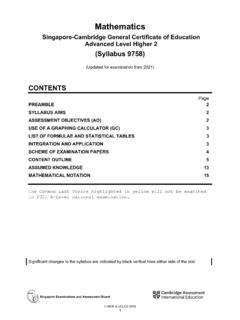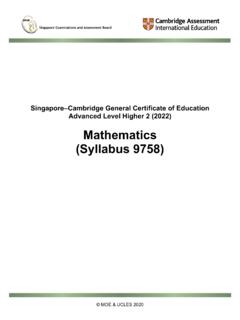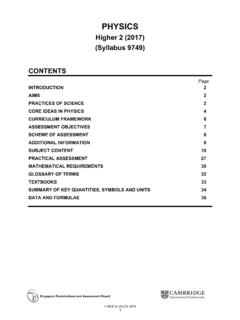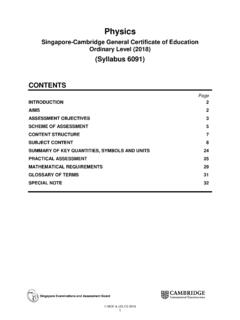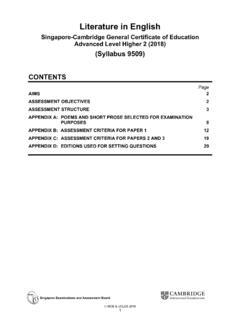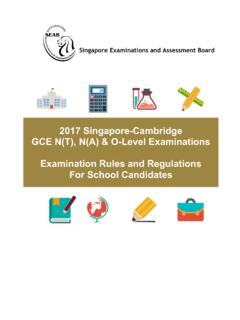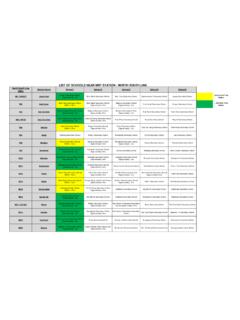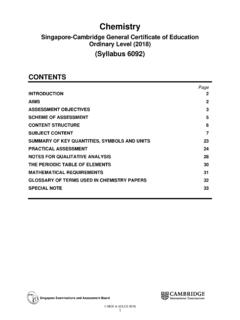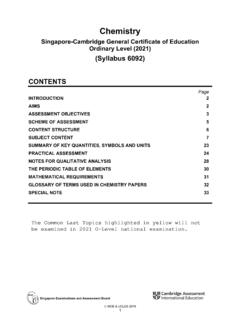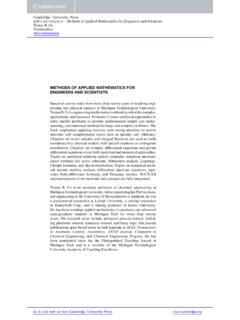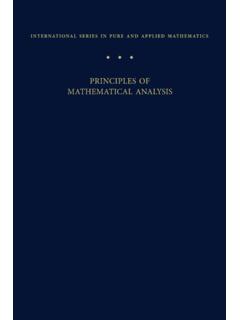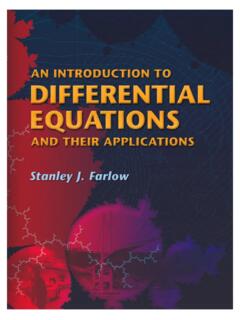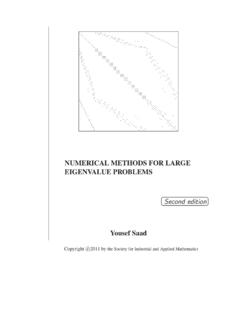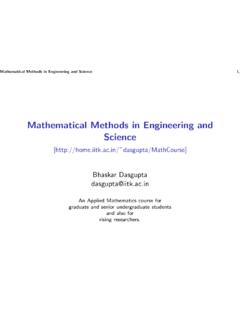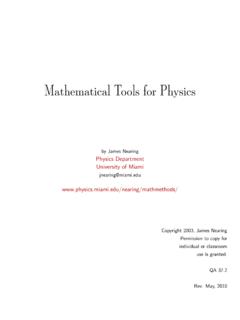Transcription of Further Mathematics (Syllabus 9649) - SEAB
1 MOE & UCLES 2020 Singapore Cambridge General Certificate of Education Advanced Level Higher 2 (2022) Further Mathematics (Syllabus 9649) 9649 Further Mathematics GCE ADVANCED LEVEL H2 SYLLABUS 2 CONTENTS Page PREAMBLE 3 SYLLABUS AIMS 3 ASSESSMENT OBJECTIVES (AO) 3 USE OF A GRAPHING CALCULATOR (GC) 4 LIST OF FORMULAE AND STATISTICAL TABLES 4 INTEGRATION AND APPLICATION 4 SCHEME OF EXAMINATION PAPERS 5 CONTENT OUTLINE 6 MATHEMATICAL NOTATION 11 9649 Further Mathematics GCE ADVANCED LEVEL H2 SYLLABUS 3 PREAMBLE Mathematics drives many of the advancements in sciences, engineering, economics and technology. It is at the heart of many of the innovative products and services today. A strong grounding in Mathematics is essential for students who aspire to be scientists or engineers or any other professionals who require mathematical tools to solve complex problems. H2 Further Mathematics is designed for students who are mathematically-inclined and who intend to specialise in Mathematics , sciences or engineering or disciplines with higher demand on mathematical skills.
2 It extends and expands on the range of Mathematics and statistics topics in H2 Mathematics and provides these students with a head start in learning a wider range of mathematical methods and tools that are useful for solving more complex problems in Mathematics and statistics. H2 Further Mathematics is to be offered with H2 Mathematics as a double Mathematics course. SYLLABUS AIMS The aims of H2 Further Mathematics are to enable students to: (a) acquire a wider range of mathematical concepts and stronger set of mathematical skills for their tertiary studies in Mathematics , sciences, engineering and other related disciplines with a heavier demand on Mathematics (b) develop thinking, reasoning, communication and modelling skills through a mathematical approach to problem-solving (c) connect ideas within Mathematics and apply Mathematics in the contexts of sciences, engineering and other related disciplines (d) experience and appreciate the rigour and abstraction in the discipline.
3 ASSESSMENT OBJECTIVES (AO) There are three levels of assessment objectives for the examination. The assessment will test candidates' abilities to: AO1 Understand and apply a wide range of mathematical concepts and skills in a variety of problems, including those that may be set in unfamiliar contexts, or require integration of concepts and skills from more than one topic. AO2 Formulate real-world problems mathematically, solve the mathematical problems, interpret and evaluate the mathematical solutions in the context of the problems. AO3 Reason and communicate mathematically through forming conjectures, making deductions and constructing rigorous mathematical arguments and proofs. 9649 Further Mathematics GCE ADVANCED LEVEL H2 SYLLABUS 4 USE OF A GRAPHING CALCULATOR (GC) The use of an approved GC without computer algebra system will be expected. The examination papers will be set with the assumption that candidates will have access to GC.
4 As a general rule, unsupported answers obtained from GC are allowed unless the question states otherwise. Where unsupported answers from GC are not allowed, candidates are required to present the mathematical steps using mathematical notations and not calculator commands. For questions where graphs are used to find a solution, candidates should sketch these graphs as part of their answers. Incorrect answers without working will receive no marks. However, if there is written evidence of using GC correctly, method marks may be awarded. Students should be aware that there are limitations inherent in GC. For example, answers obtained by tracing along a graph to find roots of an equation may not produce the required accuracy. LIST OF FORMULAE AND STATISTICAL TABLES Candidates will be provided in the examination with a list of formulae and statistical tables. INTEGRATION AND APPLICATION Notwithstanding the presentation of the topics in the syllabus document, it is envisaged that some examination questions may integrate ideas from more than one topic, and that topics may be tested in the contexts of problem solving and application of Mathematics .
5 Possible list of H2 Further Mathematics applications and contexts: Applications and contexts Some possible topics involved Kinematics and dynamics ( free fall, projectile motion, orbital motion, collisions) Functions; Calculus; Vectors Movie graphics Vectors Optics (design of mirrors) Functions; Conic Sections Optimisation problems ( maximising strength, minimising surface area) Inequalities; System of linear equations; Calculus Electrical circuits (including alternating current circuit) Complex numbers; Calculus Population growth ( spread of diseases), radioactive decay, heating and cooling problems, mixing, chemical changes, charging Differential equations Search engines, cryptography, digital music Matrices and linear spaces Financial maths ( banking, insurance) Sequences and series; Probability; Sampling distributions Standardised testing Normal distribution; Probability Market research ( consumer preferences, product claims) Sampling distributions; Hypothesis testing; Correlation and regression 9649 Further Mathematics GCE ADVANCED LEVEL H2 SYLLABUS 5 Applications and contexts Some possible topics involved Clinical research ( correlation studies) Sampling distributions; Hypothesis testing; Correlation and regression Polling Confidence intervals; Hypothesis testing Genetics Chi-square tests The list illustrates some types of contexts in which the Mathematics learnt in the syllabus may be applied, and is by no means exhaustive.
6 While problems may be set based on these contexts, no assumptions will be made about the knowledge of these contexts. All information will be self-contained within the problem. SCHEME OF EXAMINATION PAPERS For the examination in H2 Further Mathematics , there will be two 3-hour papers, each carrying 50% of the total mark, and each marked out of 100, as follows: PAPER 1 (3 hours) A paper consisting of 10 to 12 questions of different lengths and marks based on the Pure Mathematics section of the syllabus. There will be at least two questions on application of Mathematics in real-world contexts, including those from sciences and engineering. Each question will carry at least 12 marks and may require concepts and skills from more than one topic. Candidates will be expected to answer all questions. PAPER 2 (3 hours) A paper consisting of two sections, Sections A and B. Section A (Pure Mathematics 50 marks) will consist of 5 to 6 questions of different lengths and marks based on the Pure Mathematics section ( Algebra and Calculus, and Discrete Mathematics , Matrices and Numerical Methods) of the syllabus.
7 Section B (Probability and Statistics 50 marks) will consist of 5 to 6 questions of different lengths and marks based on the Probability and Statistics section of the syllabus. There will be at least two questions in Section B on application of Mathematics in real-world contexts, including those from sciences and engineering. Each question will carry at least 12 marks and may require concepts and skills from more than one topic. Candidates will be expected to answer all questions. 9649 Further Mathematics GCE ADVANCED LEVEL H2 SYLLABUS 6 CONTENT OUTLINE Knowledge of the content of H2 Mathematics is assumed. Topic/Sub-topics Content SECTION A: PURE Mathematics 1 Algebra and Calculus Mathematical induction Include: use of method of mathematical induction to establish a given result involving series and recurrence relations, derivatives, inequalities, or divisibility formulation of conjectures Complex numbers Include: geometrical effects of conjugation, addition, subtraction, multiplication and division of complex numbers loci of simple equations and inequalities such as |z c| r, |z a| = |z b| and arg(z a) = (excluding loci of |z a| = k |z b|, where k 1 and arg(z a) arg(z b) = ) use of de Moivre s theorem to find the powers and nth roots of a complex number, and to derive trigonometric identities Polar coordinates Include: simple polar curves (for 0 < 2 or < or a subset of either of these intervals.)
8 And where r is non-negative throughout the domain) use of formula = 21d2Ar for the area of a sector arc length of curves defined in polar form Conic sections Include: equation of conic sections in the cartesian form Ax2 + By2 + Cx + Dy + E = 0 focus, directrix and eccentricity geometrical properties of conic sections: sum of the distance from a point on an ellipse to a pair of fixed points is a constant difference between distances from a point on a hyperbola to a pair of fixed points is a constant reflective properties of conic sections conic sections in polar form given by = 1cosepre or = 1sinepre, where e > 0 is the eccentricity and p is the distance between the focus (pole) and the directrix 9649 Further Mathematics GCE ADVANCED LEVEL H2 SYLLABUS 7 Topic/Sub-topics Content Applications of definite integrals Include: arc length of curves defined in cartesian or parametric form volume of revolution about the x- or y-axis for curves defined in cartesian or parametric form using discs or shells as appropriate surface area of revolution about the x- or y-axis for curves defined in cartesian or parametric form Differential equations Include: analytical solution of first order and second order linear differential equations of the form.
9 (i) =df ( ) g( )dyxyx (ii) +=dp() q(),dyxyxx using an integrating factor (iii) + +=22dd0ddyyabyxx (iv) + +=22ddf( )ddyyabyxxx , where f( )x is a polynomial or pekx or p cos (kx) + q sin (kx) including those that can be reduced to the above by means of a given substitution relationship between the solution of a non-homogenous equation and the associated homogenous equation family of solution curves exponential growth model logistic growth model, equilibrium points and their stability, and harvesting Exclude phase lines, slope fields and bifurcation diagrams. 2 Discrete Mathematics , Matrices and Numerical Methods Recurrence relations Include: sequence generated by a simple recurrence relation including the use of a graphing calculator to generate the sequence defined by the recurrence relation behaviour of a sequence, such as the limiting behaviour of a sequence solution of (i) first order linear (homogeneous and non-homogeneous) recurrence relations with constant coefficients of the form un = aun 1 + b, a, b , a 0 (ii) second order linear homogeneous recurrence relations with constant coefficients modelling with recurrence relations of the forms above 9649 Further Mathematics GCE ADVANCED LEVEL H2 SYLLABUS 8 Topic/Sub-topics Content Matrices and linear spaces Include.
10 Use of matrices to represent a set of linear equations operations on 3 3 matrices determinant of a square matrix and inverse of a non-singular matrix (2 2 and 3 3 matrices only) use of matrices to solve a set of linear equations (including row reduction and echelon forms, and geometrical interpretation of the solution) linear spaces and subspaces, and the axioms (restricted to spaces of finite dimension over the field of real numbers only) linear independence and span basis and dimension (in simple cases), including use of terms such as column space , row space , range space and null space rank of a square matrix and relation between rank, dimension of null space and order of the matrix linear transformations and matrices from n m eigenvalues and eigenvectors of square matrices (2 2 and 3 3 matrices, restricted to cases where the eigenvalues are real and distinct) diagonalisation of a square matrix M by expressing the matrix in the form QDQ 1, where D is a diagonal matrix of eigenvalues and Q is a matrix whose columns are eigenvectors, and use of this expression such as to find the powers of M Numerical methods Include: location of roots of an equation by simple graphical or numerical methods approximation of roots of equations using linear interpolation and Newton-Raphson method including cases where each method fails to converge to the required root iterations involving recurrence relations of the form ( )+=1 Fnnxx including cases where the method fails to converge approximation of integral of a function using the trapezium rule and Simpson s rule approximation of solutions of first order differential equations using the Euler method (including the use of the improved Euler formula) 9649 Further Mathematics GCE ADVANCED LEVEL H2 SYLLABUS 9 Topic/Sub-topics Content SECTION B.
